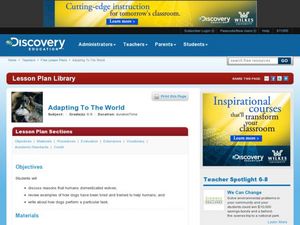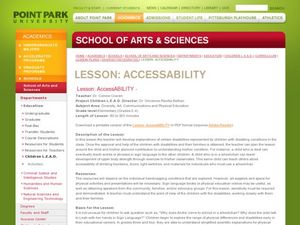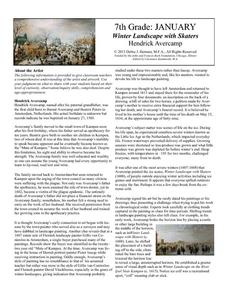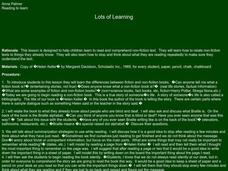Curated OER
Focusing Event to Electricity
Students explain how electrical charges behave. In this electricity lesson, students determine how far away lightning is when it strikes. They research how fabric softener reduces static electricity and share their findings in class.
Curated OER
Adapting to the World
Middle schoolers consider dog breeds that are helpful to humans and their hereditary link to wolves. In this biology lesson, student research a dog breed for traits that make it useful to humans. Students write a report of how these...
Curated OER
The Heart
Students are introduced to the parts of the heart and the flow of blood through the heart.
Curated OER
Sounds Like Science - Guitars
Learners discover that all movement produces sound waves but not all sounds can be heard with the human ear. They experiment with a variety of substances to see which are audible and which are inaudible.
Curated OER
AccessABILITY
Young scholars examine certain disabilities represented by children with disabling conditions in the class. In this generic differences and disabilities instructional activity, students design an art project depicting one word or phrase...
Curated OER
Vocabulary Elementary School
In this vocabulary instructional activity, students answer 30 questions on two pages with varied vocabulary building exercises. Included are: similes, idioms, collective nouns and meaning matching. Note: Some vocabulary here is only...
Curated OER
Health Problems 3
In this health problems worksheet, students write next to each problem if they think it's life threatening or not. Students have 15 health problems to look at.
Curated OER
ESL: Fiil-In-The-Blank Vocabulary Practice
In this ESL vocabulary worksheet, learners read sentences, "thinking" about the correct word to fill in the blank, then click on the answer button to check for accuracy.
Curated OER
Breaking News English: Australia's Death Row Plea to Singapore
In this English learning exercise, students read "Australia's Death Row Plea to Singapore," and then respond to 47 fill in the blank, 7 short answer, 20 matching, and 8 true or false questions about the selection.
Curated OER
Breaking News English: Zimbabwe's Homeless Ignored
For this English worksheet, students read "Zimbabwe's Homeless Ignored," and then respond to 47 fill in the blank, 7 short answer, 20 matching, and 8 true or false questions about the selection.
Curated OER
Sonnet 29 by William Shakespeare
In this William Shakespeare learning exercise, 10th graders focus on Sonnet 29. Students complete 15 fill in the blank questions and check using the interactive button for completion.
Curated OER
Life in the Crystal Palace
Marine biologists research sea ice communities. Assign some groups to construct paper models of sea ice communities in winter, and some to construct models of them in summer. The lesson is simplistic, but the Internet resources provided...
Curated OER
Come On Down!
Begin with an introduction to famous deep-sea submersibles. Learners work in groups to gather information on different vessels and then share with the class. Each group then uses water displacement to help calculate the density of...
NOAA
The Biggest Plates on Earth
The deepest part of the ocean is the Marianas trench where two tectonic plates meet. Scholars explore plate tectonics and their boundary types by completing hands-on activities throughout the lesson. Specific areas, such as the Galapagos...
Curated OER
Down in the Dumps
After an introduction to municipal sludge, middle school ecologists consider the pros and cons of dumping in the Hudson River Canyon. The class is split into two groups: one to debate in favor or dumping and one to debate against the...
NOAA
What's New?
Biodiversity in some areas is more diverse than one might think. Using a two-day lesson plan, pupils consider the biodiversity of the Hudson Canyon and the characteristics of one organism. They begin with an analysis of the common...
Curated OER
Seeing and Feeling Sound Vibrations
Groups rotate through a series of stations and work with a partner to observe sound waves. Children describe sound in terms of pitch, volume, and frequency. To apply their new knowledge, the class considers how these observations can...
Harper Collins
Amazing Women
Helen Keller became a teacher after her experience with Anne Sullivan, demonstrating to the world how valuable a dedicated mentor and determined spirit can be when overcoming adversity. Middle schoolers learn more about the influential...
Curated OER
ASL Lesson 2
Empower your non-verbal, autistic, or learning-impaired child with sign language. Lesson 2 in this functional and straight-forward series focuses on vocabulary related to familial relationships and ASL grammar. Video clips and images of...
Curated OER
Setting the Story: Techniques for Creating a Realistic Setting
“It was a dark and stormy night.” Thus begins the 1830's novel Paul Clifford and, of course, all of Snoopy’s novels! Encourage young writers to craft settings for their stories that go beyond Edward Bulwer-Lytton’s often-mocked phrase...
Concordia University Chicago
Winter Landscape with Skaters by Hendrick Avercamp
In need of a quick set of ideas to use on a wintery day? Why not analyze Winter Landscape with Skaters with your class? After a thorough discussion, learners compare and contrast two paintings, research what curators do, draw landscapes,...
Curated OER
Dulce et Decorum est by Wilfred Owen
It is entirely fitting and proper that Wilfred Owen’s powerful “Dulce et Decorum Est” is the poem used for an exercise in close reading, discussion, analysis, and argumentative writing. Class members discuss focus questions in pairs,...
San Francisco Symphony
The 20% of Beethoven
Compare Beethoven's fifth symphony to latin music and disco. Learners will listen to and discuss the elements found in the first part of Beethoven's composition. They'll then look for the same elements in Tito Puente and Bee Gees songs....
Curated OER
Reading to Learn
Children learn to read and comprehend non-fiction text and explore how to relate non-fiction texts to things they already know. They then examine how to stop and think about what they are reading repeatedly to make sure they understand...

























